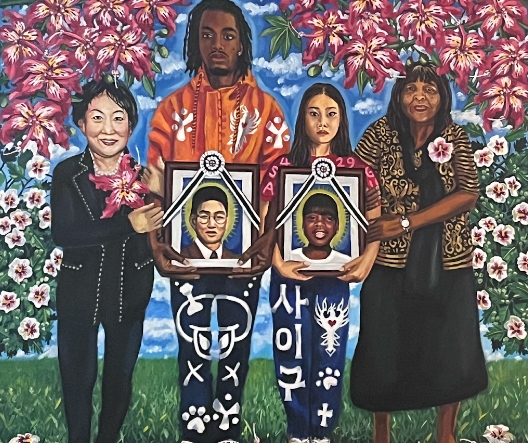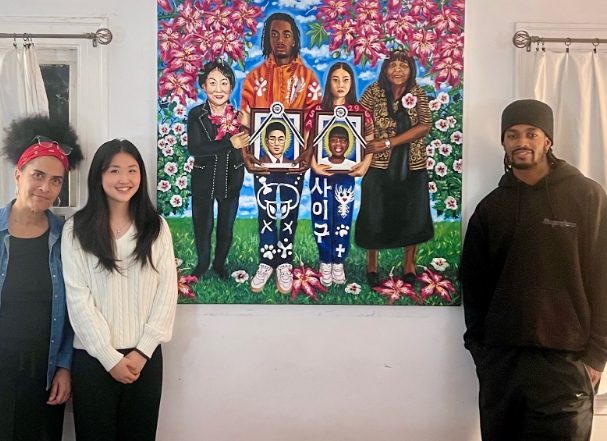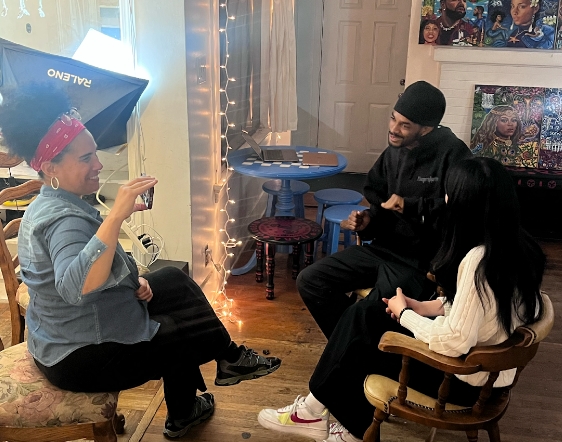
I discovered that one of my peers at Immaculate Heart, Zion Ferugson, was the daughter of Lili Bernard, and sister of rapper, artist and actor H.E.Z.Y, Elias Ferguson. A personal interview was conducted by Yang to receive input from Lili Bernard, H.E.Z.Y, and Zion Ferguson regarding the efficacy of the exhibit.
Lili Bernard, a co-curator for the Phoenix Project, painted a piece named Her Granddaughter, Her Son specifically for the exhibit.
When asked about her experience working with Korean Americans, Bernard was quick to point out that her cultural upbringing had always included Korean Americans. Rather than this exhibit being a starting point for diversity and inclusion for Bernard, it served as a creative outlet for her cultural knowledge of the two communities.

Lili gives an in-depth explanation of her painting Her Granddaughter, Her Son, from the people depicted to the symbolism of the flowers and religious innuendos. Meant to respond directly to the LA Riots, Bernard paints Edward Lee’s grandmother on the far left, two models as representatives of the Korean and African American communities and Latasha Harlins’s grandmother on the far right. A Korean American is seen holding a Korean style portrait of Latasha Harlins. “I grew up with a lot of Korean people around me, which subsequently meant that I had to attend funerals as well.”
Lili described as the inspiration behind the Korean traditional blue and white ribbons. The same is done on the left hand side of the painting where an African American is seen holding a portrait of Edward Lee, a teenage victim of Korean crossfire.
This strategic placing of the people as Edward Lee’s mother is seen grasping onto a Black American and Latasha Harlins grandmother is seen holding onto a Korean American’s arm is Bernard’s attempt to convey that race is a social construct, and these two communities need to accept the possibility of being anyone’s family in order to embrace the idea of true love.
More specifically, on the clothing of the people depicted in the portrait, Bernard has placed dog paws to symbolize the dehumanization of these communities, and how loving like dogs in an unconditional manner can help unify and identify common cultural hardships of the two immigrant communities.

On March 3, 1991, Rodney King was beaten to death with police batons in attempts to get him to comply with orders to lay down. 13 days later on March 16, Latasha Harlins, a 15 year old African American girl was shot to death in the back of the head by Soon Ja Du (Korean: 두순자), a Korean convenience store owner. Less than two months later on April 30, 1992, Edward Lee, a Korean 18 year old teenager was shot in crossfire during his return to Koreatown in an attempt to aid his people by a fellow Korean American shop owner.
A year later on April 29, 1992, the jury acquitted all four police officers involved in the Rodney King incident from charges of assault. On November 15, 1991, the jury found that Du’s gunfire was voluntary. Despite these findings pointing toward a maximum sentence of 16 years, trial judge Joyce Karlin sentenced Du to five years of probation, 400 hours of community service, and a $500 fine. In memory of Edward Lee, and previous injustices that resulted from racial tensions, minority community leaders including African and Korean Americans started the LA Riots, also known as “Sa-I-Gu” meaning 4-2-9 (April 29).

<Seoyoung Yang Student reporter>hseoyoungy@gmail.com
Seoyoung Yang is a Sophomore Student in Immaculate Heart High School. She is interested in Koreatown, its gentrification phenomenon, and Korean American culture.
관련기사 주민 68% 폭동 다시 발생 가능.429 폭동 30년 인종갈등 악화, 더 비관적
관련기사 429 30주년 차세대 컨퍼런스..30일 한인타운서
관련기사 잿더미 됐지만 떠날 수 없어 40년 자리 지킨 리커스토어 한인 부부 사연






